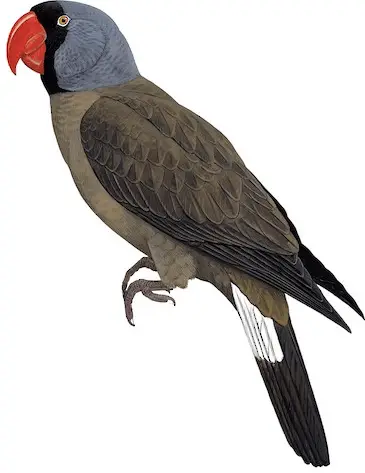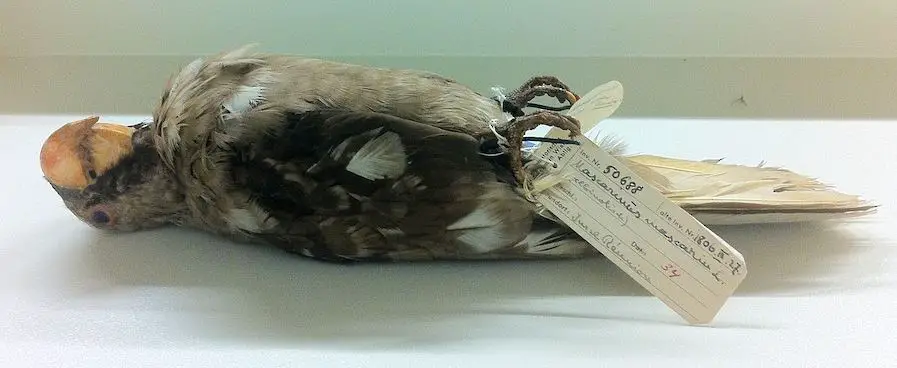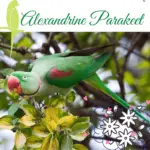
Mascarene parrot or Réunion parakeet ( Mascarinus mascarinus ) is an extinct species of parrot . It was the only species in the genus Mascarinus and inhabited Réunion and possibly Mauritius.
The Réunion parakeet became extinct in the wild after 1770 but survived in captivity until the 1780s.
Mascarinus mascarin or Monotypic genus possibly better merged with Coracopsis; further study required. Monotypic.
personality
Colored drawing of a Réunion parakeet
Illustration by John Gerrard Keulemans (1907) for Walter Rothschild’s Extinct Birds. Like all the other illustrations, this image is based on a discolored museum specimen whose tail was damaged by sulfuric acid. Plumage markings and coloring are therefore not lifelike.
The Mascarene Parrot was a medium-sized parrot, roughly the size of an Eclectus parrot, with a body length of around 35 cm. It had a relatively large head for a parrot of its size; the beak and claws were also relatively strong. Its twelve-feathered tail was not stepped but slightly rounded at the end.
The head of the Mascarene Parrot was light blue-grey feathers, around the beak there was a black band that either ran down the throat or also covered its sides. The back, ventral side, rump, and wings were apparently dark grey.
Descriptions of a brown rump and brown wings no longer refer to living individuals, but to specimens that appear to have discolored over time.
The middle two tail feathers were uniformly colored dark ash-grey; the outer ten were of the same basic color but colored white from the base to about one-third of the total length.
The beak and cere were colored bright red, as was the skin around the eyes. The iris was red. The parrot’s unfeathered lower legs were pale, its claws tinged grey-brown.
Subspecies
Last accounts of wild individuals relate to 1775, and were not mentioned by J. B. Bory writing in 1804, so the species may well have been extinct in the wild by then; the estimated date of extinction taken as the mid-point, c. 1790.
Captive individuals in Europe had also died by this time; a single bird was said to have survived in the King of Bavaria’s menagerie until at least 1834, but there is no reliable evidence for this as the specimen was not preserved. Extinction was caused by excessive hunting pressure and deforestation by settlers.
Distribution
As things stand today, the Réunion parakeet’s range only included the island of Réunion. Here the species was described and subfossil bone material was found. It is unclear whether the Mascarene Parrot was also native to nearby Mauritius.
Taxonomy
The first mention of the Réunion parakeet is in 1674 in the travelogue of Père Dubois, who speaks of “parrots, slightly larger than a pigeon, with plumage of a squirrel-grey color, a black cap on the head, the beak large, strong & of a fiery color”.
In the taxonomic sense, the Mascarene Parrot was first described by Mathurin-Jacques Brisson in 1760 as Psittacus Mascarinus, but not according to the rules for the binomial used today.
Carl von Linné’s description as Psittacus muscarinic from 1771 is therefore valid. René-Primevère Lesson finally placed the species in a separate genus in 1831mascarinus.
Classification
Like most bird species of the Mascarene Islands, the Réunion parakeet’s ancestor probably colonized Réunion across the islands of the northern Indian Ocean.
Like other parrot genera of the Mascarene Islands, Mascarinus probably does not originate from local radiation but originates from separate colonization, the species is probably of more recent origin than the Rodrigues’ parrot ( Necropsittacus rodericanus ) and the Mauritius parrot ( Lophopsittacus mauritianus ).
The exact family relationships are unclear. It could be related to the Réunion gray parakeet ( Psittacula cf.bensoni, possibly conspecific with the Mauritian gray parakeet ), which was also predominantly gray in color. The red and wide beak of the Mascarene parrot speaks for a classification in the tribe Psittaculini.
Conservation Status

The Mascarene Parrot disappeared in the 1770s. It’s unlikely that its extinction was primarily due to rats or cats, which by then had existed on the island for around a century.
It is more likely that the species succumbed to hunting pressures from escaped slaves feeding on wild birds in the island’s inaccessible highlands. Some Parakeets survived in captivity in Paris for at least until 1784.




















